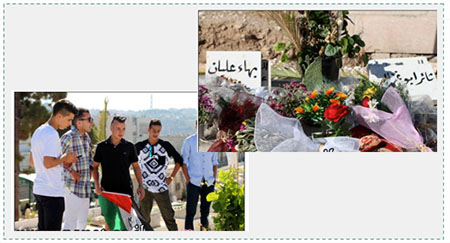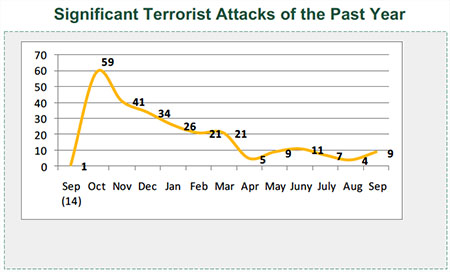
Left: Young Palestinians visit the graves of shaheeds in the Mujahideen Cemetery in east Jerusalem. Right: The graves of Bahaa' Alian and Ta'er Abu Ghazala, two terrorists who carried out attacks in the previous wave of Palestinian terrorism.[1] Flowers were placed on the graves at the beginning of the Muslim holiday of Eid al-Adha (Panet, September 12, 2016).
Overview
|
1. After five months of a decrease in the scope of terrorist attacks and a year after the outbreak of the previous wave of Palestinian popular terrorism, another wave broke out. During eight days, between September 16 and 23, 2016, ten significant terrorist attacks were carried out. Eight of them were stabbing attacks. Six Israelis were wounded. Eight of the terrorists were killed. At least two attacks were prevented when the Israeli security forces detained Palestinians who were carrying knives. An attack planned by a Palestinian girl from Abu Dis was prevented by the Palestinian Authority (PA) security forces. As in the previous wave, most of the attacks were carried out in and around Hebron, Gush Etzion and east Jerusalem. |

2. Prominent among the Palestinians participating in the current wave of terrorist attacks have been relatives and close friends of terrorists killed in the previous wave, which began a year ago (the second half of September 2015). At least five of the ten recent terrorist attacks were carried out by a friend or relative(especially of the terrorists killed between September 2015 and March 2016). Beyond the basic national and religious motives, the young Palestinians carrying out the attacks in the current wave apparently identify with those killed in the previous wave and want to exact revenge. About half of the attacks were carried out at the same locations and using the same modus operandi as in the previous wave.
3. The current wave of terrorist attacks began a short time after the Muslim holiday of Eid al-Adha and may have been influenced by it. It is a common Muslim custom to visit graves, including graves, of shaheeds on important religious holidays (especially Eid al-Fitr and Eid al-Adha, which fell on September 12 this year, four days before the outbreak of the current wave of terrorism). As tensions with Israel mount, more Palestinians visit graves of shaheeds, as they did during the first and second intifadas. Generally speaking, relatives of the shaheeds visit their graves, but so do people who identify with the shaheeds, and want to preserve their memories and turn them into role models.
| 4. The phenomenon of revenge attacks may be infectious and feed on itself, and a terrorist who carries out one attack may influence others who identify with and want to copy him (or her). Thus Palestinians may continue and intensify "revenge attacks," in view of the Jewish High Holidays, which fall in October this year, and during which the previous Palestinian terrorist campaign peaked. |
[1]On October 13, 2015, Bahaa' Alian carried out a combined shooting and stabbing attack on a bus in the Armon Hanatziv neighborhood, Jerusalem, killing three Israelis. On October 8, 2015, Ta'er Abu Ghazalacarried out a stabbing attack near the Kiriya in Tel Aviv wounding five Israelis. He was shot and killed by an IDF officer.






